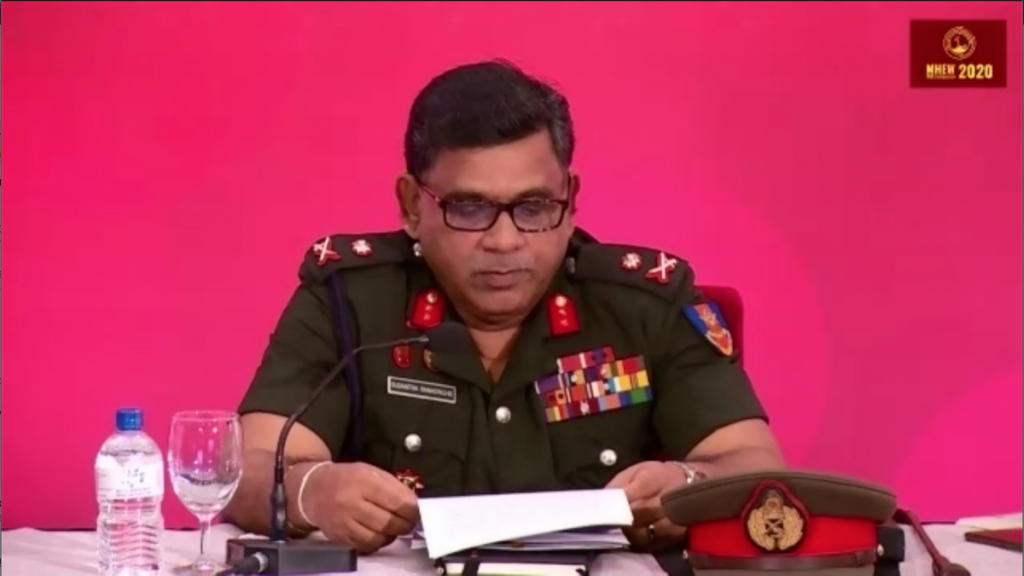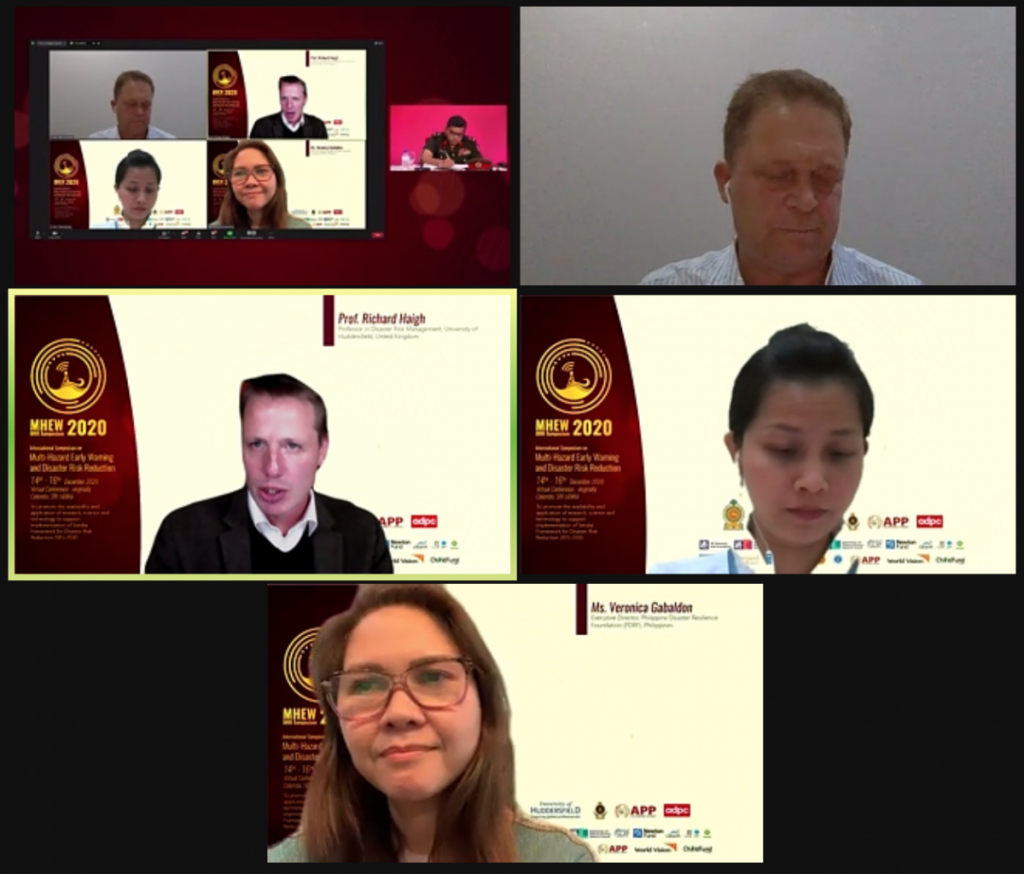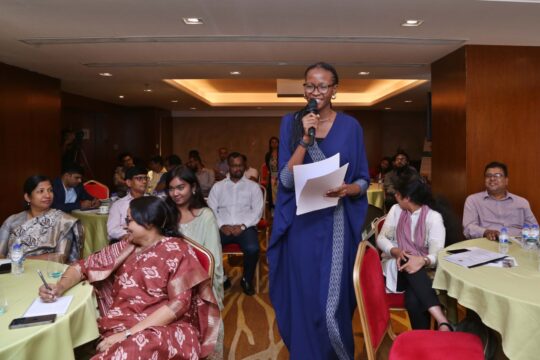The International Symposium on MHEW and DRR was held online on 14 – 16 December 2020 to promote the availability and application of research, science, and technology to support the implementation of the Sendai Framework for Disaster Risk Reduction 2015 – 2030. The symposium was originally scheduled to be held in Colombo, Sri Lanka on 16 – 18 March 2020 but it was postponed due to restrictions placed by the COVID-19 pandemic.
The event was a joint collaboration between the Ministry of Defence, Disaster Management Centre (DMC), Sri Lanka, and Global Disaster Resilience Centre, University of Huddersfield, UK, the Asian Disaster Preparedness Center (ADPC), with several other partner universities, partner UN agencies, Japanese International Cooperation Agency (JICA), and other partners.
The first plenary session- “Science, Policy and Practice Nexus for Risk Analytics, Early Warning Systems, and Emergency Operations Centers: Perspectives from the Asian Countries’ took place on 14 December 2020. It was co-organized by the Disaster Management Center of Government of Sri Lanka, the Asian Preparedness Partnership (APP), ADPC, and the University of Huddersfield.
The session focused on providing insight and perspective on current practices and strengthening the nexus between risk analytics, early warning systems (EWS), and emergency operating centers (EOCs) to accelerate the implementation of the Sendai Framework for Disaster Risk Reduction (SFDRR) with a specific focus Target E – ‘substantially increase the number of countries with national and local disaster risk reduction strategies by 2020’, and Target G – ‘substantially increase the availability of and access to multi-hazard early warning systems and disaster risk information and assessments to people by 2030’. It was an opportunity to share good practices from South and South-East Asia, discuss the perspectives and roles of multiple stakeholders, and the linkages with research, policy, and practice to strengthen this nexus.

Major General (Retd.) Sudantha Ranasinghe Director General (DG), Disaster Management Center (DMC), Ministry of Defense, Government of Sri Lanka, served as the co-chair and commenced the discussion with opening remarks. He emphasized how EOC are the nerve centers during disaster response with the capacity to reach the last mile- “These centers serve as the hub for disseminating and transmitting information for early warning. They also coordinate the response action and manage the resources.” Major General (Retd.) Sudantha also indicated that EWS serves to enhance preparedness to prevent the loss of lives and mobilize resources. Professor Richard Haigh, Global Disaster Resilience Centre, University of Huddersfield, United Kingdom was also a co-chair. He introduced the panelists, provided an overview of the session and instructions for the audience to participate in the question and answer session after all of the presentations.
Insights at National and Regional Levels
Mr. Hans Guttman, Executive Director, ADPC, presented on ‘Amplifying SFDRR Implementation: Target E and G’. He provided examples of how ADPC recognized the importance of assessment in DRM to support Target E of the SFDRR, “ADPC and the UNDRR have assisted 22 countries in institutional assessment of the current state of affairs in DRM and Climate Resilience, including roles, responsibilities, and potential linkages of the various DRM agencies/institutions. The reports were produced to highlight the key challenges towards coherence and make recommendations for progress in DRM governance.” He also elaborated upon the ADPC’s key activities and projects that are contributing to the Target G of the SFDRR.
Mr. Raza Iqbal, National Disaster Management Authority (NDMA), Pakistan, presented on ‘Application of Risk Analytics in the implementation of the National Disaster Response Plan (NDRP) and EOCs’. Mr. Iqbal equated rapid response in disaster events to effective communication- “Once we receive early warning information from the Pakistan Meteorological Department, we disseminate this information to various ministries and advisories through SMS alerts and these messages reach the community level.”
Ms. Veronica Gabaldon, Executive Director, Philippine Disaster Resilience Foundation (PDRF), the Philippines, presented on ‘Risk Monitoring, Business Continuity Planning, and EWS in the Private Sector’. She elaborated that the PDRF’s ‘Hazard and Disaster Analysis for Business Resilience’ (HANDA) is an online platform for reporting, monitoring, and incident management. Ms. Gabaldon detailed how the platform has coordinated efforts by the private sector, “In monitoring and assessing the impacts on the communities, we can call on the private sector’s resources. We can ensure that resources and funds are strategically allotted.”

Mr. Sushil Bhandari, Section Officer, National Emergency Operation Centre (NEOC), Ministry of Home Affairs (MoHA), Nepal, presented on ‘Early Warning to Early Actions: Role of Subnational Disaster Governance in Nepal’. He stated that local governments are not equipped with the resources to address disaster events. Mr. Bhandari emphasized that policy development is necessary to link national and sub-national EOCs of the government: “Policies are developed with the national guidelines and international policies as well. We have established EOCs at the local level. Another important aspect was the technological setup for risk knowledge.”
Ms. Thiri Maung, Deputy Director, Emergency Operation Center, Department of Disaster Management (DDM), Ministry of Social Welfare, Relief and Resettlement, Myanmar, presented on ‘National Emergency Operation Center and the role of Civil Society Organizations in Response’. She explained that disaster management policies and legislations have been administered in DDM to build a resilient and responsive community in Myanmar. Ms.Maung cited the EOCs’ efficacy during the 2015 floods- “The center hosted multi-agency coordination with ASEAN and UN agencies. It also monitored the situation and provided updates to relevant decision-makers.”
Question and Answer Session
Following the presentations, Professor Richard Haigh moderated a question and answer session with the panelists. Professor Haigh noted that there were many participants from the research and science community. With this in mind, he questioned Mr. Guttman about which kinds of development would organizations such as ADPC require to develop the nexus. Mr. Guttman cited that there is a need to follow through with new tools and information-gathering techniques that bring the research and science community together with field practitioners. He specified that technologies such as remote sensing are establishing mechanisms for information to be relayed to all stakeholders.
Professor Haigh commended PDRF for its initiatives and asked Ms. Gabaldon if the sector is connected with emergency national operations centers. She stated that the private sector works to complement the government’s interventions and the sector’s EOCs to centralize coordinate their efforts accordingly to avoid duplication and reach the remotest affected communities. She also pointed out that they are constantly active in capacity building and training with the government and other organizations to be better equipped to address disaster events.
Professor Haigh noted that disaster management initiatives and legislation were closely linked- he requested Ms. Muang to provide insight on how this has supported the nexus between risk analytics, EWS, and the EOCs. Ms. Maung explained that the nation’s DMC was developed in accordance with the Disaster Management Law of Myanmar and its main function is to assist the National Disaster Management Committee to make informed decisions. She added the DMC is in a position to be a powerful tool in strengthening the nexus in Myanmar.
Major General (Retd.) Sudantha Ranasinghe closed the plenary session by thanking the panelists for their presentations and the enriching discussions.
Click here, to view the entire plenary session.


